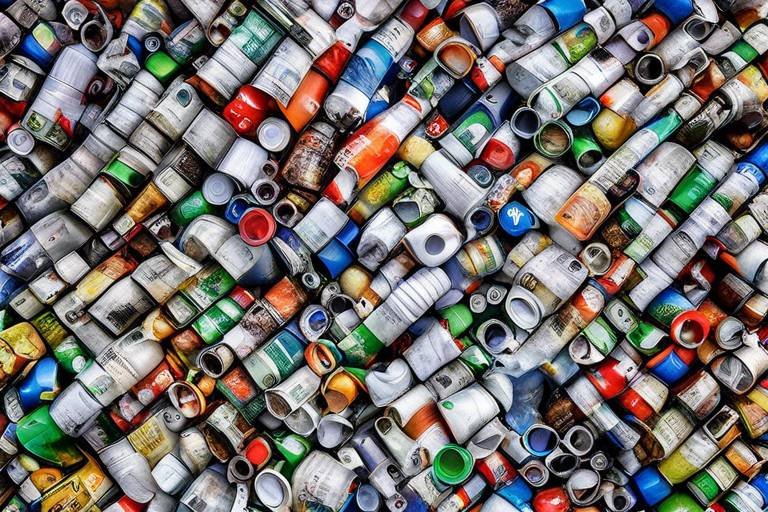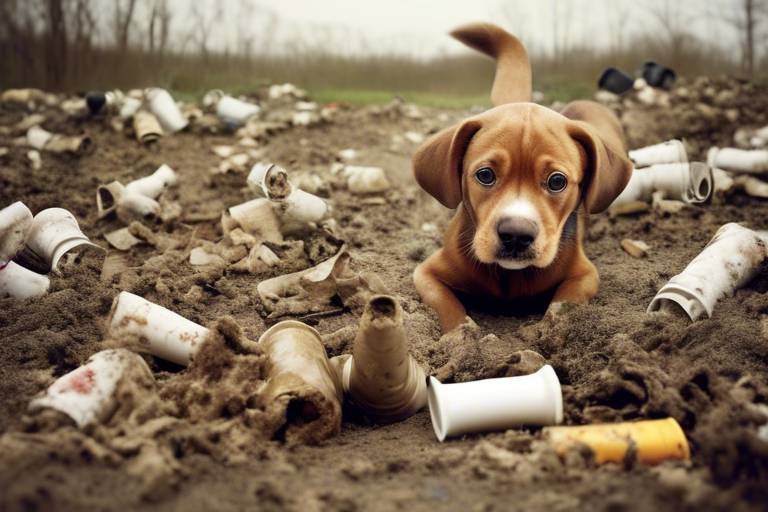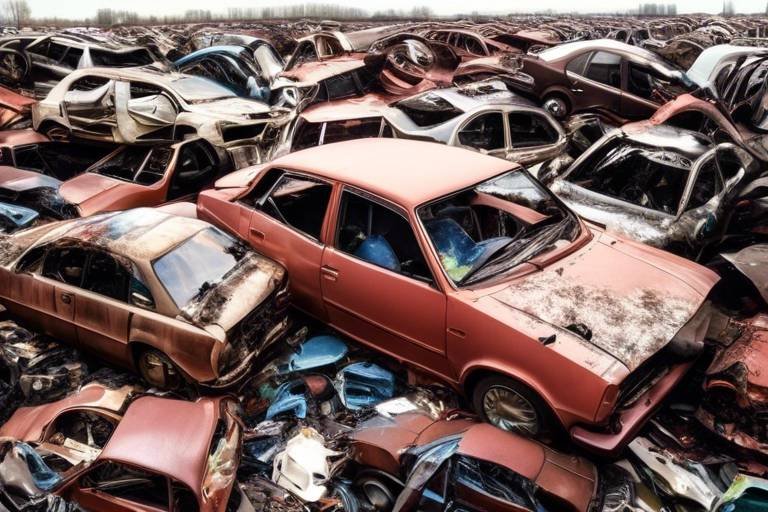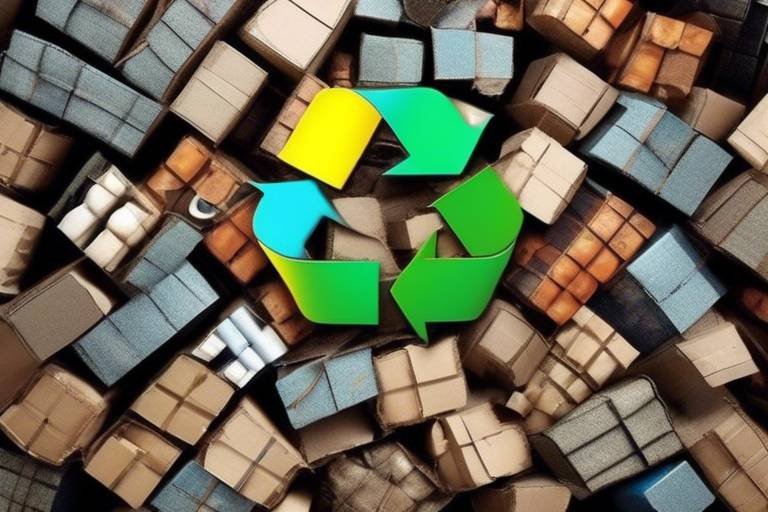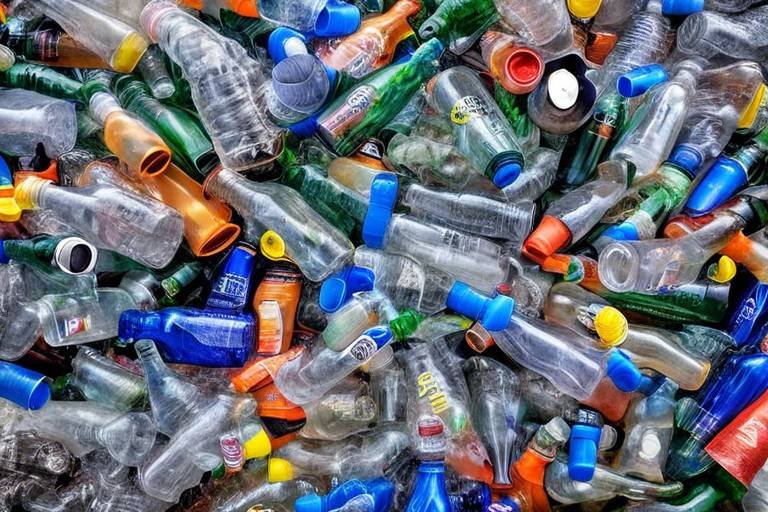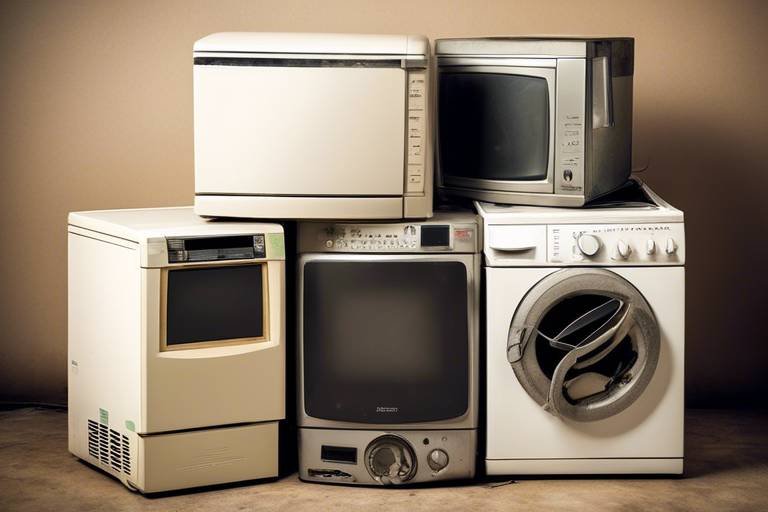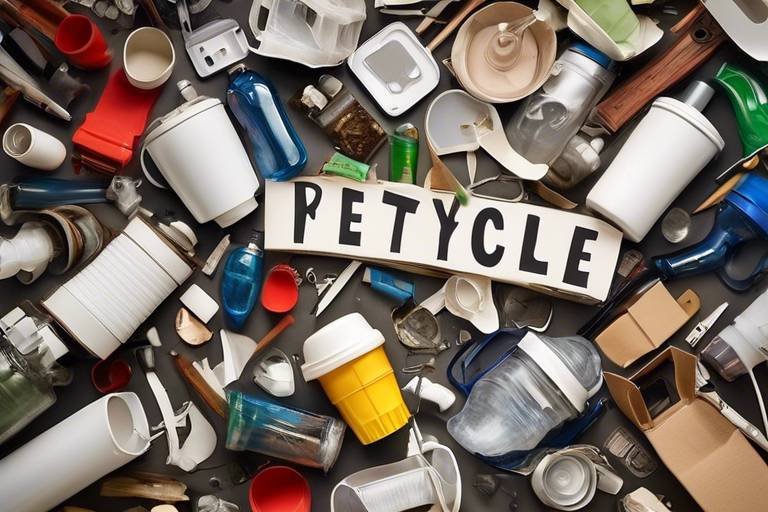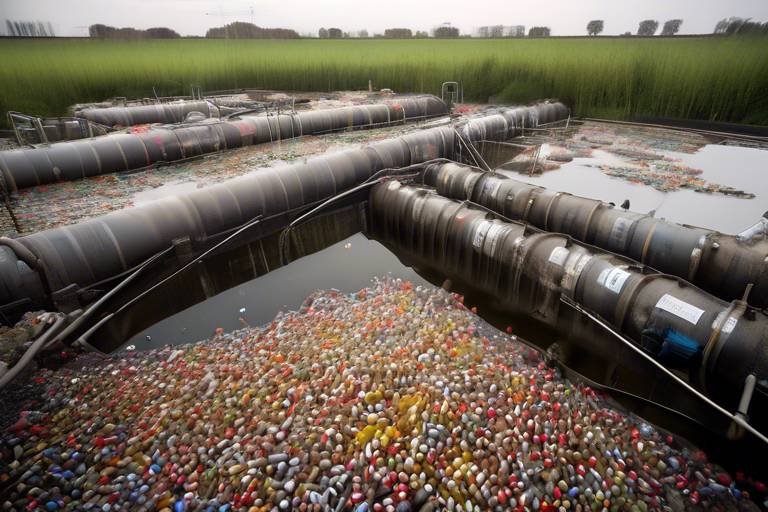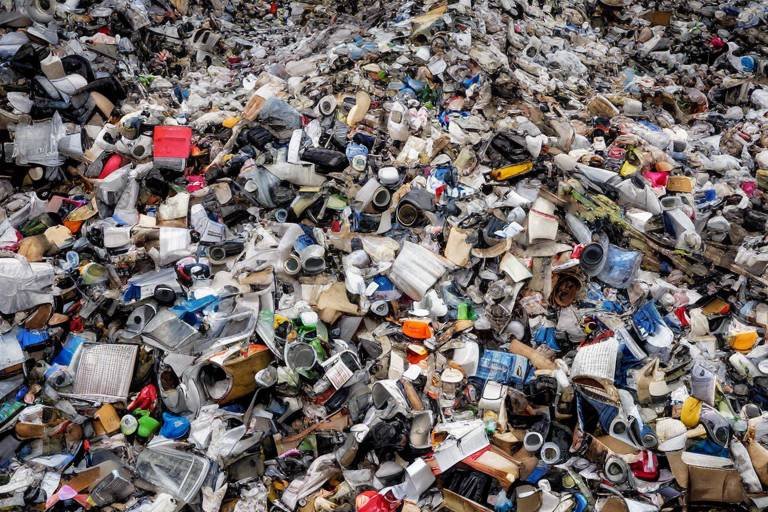Can We Achieve a Circular Economy Through Recycling?
In a world grappling with the consequences of overconsumption and waste, the question arises: can we truly achieve a circular economy through recycling? The concept of a circular economy revolves around a revolutionary approach that aims to keep resources in use for as long as possible, extracting maximum value from them while in use and then recovering and regenerating products at the end of their life cycle. Recycling stands at the forefront of this movement, acting as a pivotal strategy to reduce waste and promote sustainability.
Imagine a world where products are designed with their entire lifecycle in mind—where materials flow seamlessly from one use to the next, rather than ending up in overflowing landfills. This vision is not just a dream; it can be realized through effective recycling practices. By embracing recycling, we can significantly reduce the amount of waste generated, conserve valuable resources, and lower greenhouse gas emissions. However, achieving a circular economy is not merely about recycling; it requires a systemic change in how we produce, consume, and dispose of goods.
One of the most compelling aspects of recycling is its ability to transform discarded materials into new products, thereby supporting a more sustainable and responsible consumption model. This process not only conserves natural resources but also fosters innovation and economic growth. For instance, recycled materials often require less energy to process compared to virgin materials, leading to substantial energy savings and a reduction in carbon footprint.
However, the path to a circular economy through recycling is fraught with challenges. Contamination of recyclable materials, fluctuating market demand for recyclables, and inadequate infrastructure can hinder recycling efforts. To overcome these obstacles, we must invest in better education about recycling practices, improve waste management systems, and develop technologies that enhance the efficiency of recycling processes. By addressing these challenges head-on, we can unlock the full potential of recycling as a cornerstone of a circular economy.
In conclusion, while the journey towards a circular economy through recycling presents its fair share of challenges, the benefits far outweigh the hurdles. With concerted efforts from individuals, businesses, and governments, we can create a sustainable future where resources are valued and waste is minimized. So, are we ready to embrace this change? The answer lies in our collective actions today.
- What is a circular economy? A circular economy is an economic system aimed at eliminating waste and the continual use of resources. It contrasts with a traditional linear economy, which follows a 'take, make, dispose' model.
- How does recycling contribute to a circular economy? Recycling helps to close the loop by converting waste materials into new products, thus reducing the need for virgin resources and minimizing environmental impact.
- What are the main challenges of recycling? Challenges include contamination of recyclable materials, fluctuating market demand, and insufficient recycling infrastructure.
- What role do governments play in recycling? Governments can implement policies that support recycling initiatives, provide funding for infrastructure improvements, and promote public awareness about the importance of recycling.

The Concept of a Circular Economy
Understanding the principles of a circular economy is essential for anyone interested in sustainability and environmental conservation. Unlike the traditional linear economy, which follows a 'take, make, dispose' model, a circular economy strives to create a system where resources are used efficiently and waste is minimized. Imagine a world where products are designed to last longer, be reused, and ultimately recycled into new products, rather than ending up in a landfill. This shift in thinking is not just a dream; it's a necessity for our planet's future.
The circular economy emphasizes resource efficiency, waste reduction, and sustainable production. It aims to create closed-loop systems that not only minimize environmental impact but also promote long-term ecological balance. This approach is crucial as we face increasing challenges such as climate change, resource depletion, and pollution. By adopting circular economy principles, we can ensure that we are not just borrowing resources from the earth but are instead working towards replenishing and sustaining them.
In a circular economy, products are not merely consumed and discarded. Instead, they are designed with their entire lifecycle in mind. This means that manufacturers consider how a product can be reused, repaired, or recycled right from the start. For example, consider how smartphones are often upgraded but rarely recycled. If manufacturers designed phones to be easily disassembled, the materials could be recovered and reused, significantly reducing the need for new resources. Such a shift would not only benefit the environment but could also lead to economic advantages through the creation of new markets for recycled materials.
Furthermore, the circular economy encourages collaboration among different sectors. For instance, businesses can partner with recycling companies to ensure that materials are recovered and reused efficiently. Governments can also play a significant role by implementing policies that support recycling initiatives and incentivize sustainable practices. By working together, we can create a more resilient and sustainable economy that benefits everyone.
In summary, the concept of a circular economy is about transforming our current systems to prioritize sustainability and resource efficiency. It requires a fundamental change in how we think about production and consumption. By embracing these principles, we can pave the way for a greener future, where resources are valued, waste is minimized, and the environment is protected for generations to come.
- What is a circular economy? A circular economy is an economic system aimed at eliminating waste and the continual use of resources. It focuses on keeping products, equipment, and infrastructure in use for longer, thus improving the productivity of these resources.
- How does recycling fit into a circular economy? Recycling is a key component of a circular economy as it allows materials to be recovered and reused, reducing the need for new resources and minimizing waste.
- What are the benefits of a circular economy? A circular economy can lead to reduced environmental impact, conservation of resources, economic growth through new job creation, and increased resilience against resource scarcity.

The Role of Recycling in Sustainability
Recycling is not just a buzzword; it's a vital cog in the machinery of sustainability. Imagine a world where waste doesn't simply pile up in landfills, but instead, discarded materials are transformed into valuable resources. This is precisely what recycling aims to achieve. By diverting waste from landfills, recycling plays an essential role in reducing the overall environmental footprint of our consumption habits. It allows us to conserve precious natural resources, such as timber, water, and minerals, which are often depleted through traditional manufacturing processes.
But how does recycling contribute to sustainability? Let's break it down. First and foremost, recycling reduces the need for raw materials. When we recycle, we turn materials like paper, glass, and plastic back into usable products, which means we don't have to extract and process as much from the earth. This not only conserves resources but also lowers greenhouse gas emissions associated with extraction and processing. In fact, recycling can significantly reduce carbon emissions, contributing to a healthier planet.
Moreover, recycling cultivates a culture of responsible consumption. It encourages individuals and businesses alike to think critically about their waste and how they can minimize it. By participating in recycling programs, communities foster a sense of shared responsibility for the environment. This collective effort can lead to a ripple effect, inspiring more sustainable practices across various sectors.
Another crucial aspect of recycling's role in sustainability is its capacity to create new economic opportunities. The recycling industry generates jobs in collection, processing, and manufacturing. Not only does this create employment, but it also stimulates local economies. For instance, consider the job creation statistics: every job in the recycling sector can lead to multiple jobs in related fields, from logistics to manufacturing. This interconnectedness highlights how recycling doesn't just benefit the environment; it also supports economic resilience.
However, the impact of recycling extends beyond just the immediate benefits. It plays a critical role in fostering innovation. As companies strive to improve their recycling processes, they often develop new technologies and methods that enhance efficiency. For example, advancements in sorting technologies can lead to higher recycling rates and better quality materials for reuse. This kind of innovation is essential for achieving long-term sustainability goals.
In summary, recycling is a cornerstone of sustainability. It reduces waste, conserves resources, lowers emissions, and stimulates economic growth. But the journey doesn't end here; we must all play our part in promoting and participating in recycling initiatives. As we embrace a more sustainable lifestyle, we can help ensure that recycling remains a crucial aspect of our environmental strategy.
- What materials can be recycled? Most common materials include paper, cardboard, glass, metals, and certain plastics. Always check local guidelines for specific recycling rules.
- How does recycling help the economy? Recycling creates jobs, reduces the costs associated with waste disposal, and lowers the demand for raw materials, which can lead to economic growth.
- Can recycling really make a difference? Yes! Recycling conserves natural resources, reduces pollution, and helps combat climate change, making a significant positive impact on our planet.

Benefits of Recycling
Recycling is not just a buzzword; it's a powerful tool that can drive us toward a more sustainable future. When we recycle, we are essentially giving new life to materials that would otherwise end up in a landfill. This process offers a multitude of benefits that extend beyond mere waste reduction. Let's dive into some of the key advantages that recycling brings to the table.
First and foremost, resource conservation is a significant benefit of recycling. By reprocessing materials like paper, glass, and metals, we can significantly reduce the need for extracting new raw materials. For instance, recycling one ton of paper can save 17 trees, 7,000 gallons of water, and 4,100 kilowatts of electricity. This not only preserves our natural resources but also helps maintain biodiversity and the health of ecosystems.
Moreover, recycling plays a crucial role in energy savings. The energy required to produce new products from raw materials is often much higher than that needed to create the same products from recycled materials. For example, producing aluminum from recycled materials uses 95% less energy than producing it from bauxite ore. This energy efficiency translates to reduced greenhouse gas emissions, which is a win-win for our planet.
Another important aspect is the reduction of landfill use. Landfills are not just unsightly; they contribute to a myriad of environmental problems, including soil and water contamination. By recycling, we can significantly decrease the volume of waste that ends up in these sites. In fact, recycling and composting prevented the release of 186 million metric tons of carbon dioxide equivalent into the air in 2013 alone. That’s like taking 39 million cars off the road!
Recycling also fosters innovation and creates job opportunities. The recycling industry is a rapidly growing sector that supports jobs in various fields, from collection and processing to manufacturing. According to the National Recycling Coalition, recycling and reuse activities in the United States alone accounted for over 1.1 million jobs and generated $236 billion in revenue. This economic impact is vital for local communities and contributes to overall economic growth.
Lastly, recycling promotes environmental stewardship. When individuals and businesses engage in recycling, they cultivate a sense of responsibility toward the environment. This mindset can lead to more sustainable practices, such as reducing consumption and choosing eco-friendly products. It fosters a culture of sustainability where people are more conscious of their consumption habits and their impact on the planet.
In summary, the benefits of recycling are far-reaching and multifaceted. From conserving resources and saving energy to reducing landfill waste and creating jobs, recycling is a cornerstone of a sustainable future. As we strive to establish a circular economy, embracing recycling is not just beneficial; it's essential.
- What materials can be recycled? Most common materials include paper, cardboard, glass, metals, and certain plastics. Always check local guidelines for specifics.
- How does recycling help the economy? Recycling creates jobs in collection, processing, and manufacturing, while also reducing costs associated with waste disposal.
- Can recycling really make a difference? Absolutely! Recycling reduces landfill waste, conserves natural resources, and minimizes pollution, contributing to a healthier environment.

Economic Advantages
Recycling is not just about saving the planet; it’s also a powerful engine for economic growth. Imagine a world where waste is transformed into wealth—this is the essence of recycling. By diverting materials from landfills and reintroducing them into the production cycle, recycling creates a myriad of economic opportunities. It’s like turning trash into treasure, and who wouldn’t want that?
One of the most significant economic advantages of recycling is the creation of jobs. According to recent studies, the recycling industry generates approximately 1.17 million jobs in the United States alone. These jobs span various sectors, including collection, processing, and manufacturing, providing employment opportunities for countless individuals. As communities embrace recycling, they not only reduce waste but also stimulate local economies and foster job growth.
Moreover, recycling contributes to cost savings for both businesses and consumers. By recycling materials, companies can reduce their reliance on virgin resources, which often come with hefty price tags. For instance, using recycled aluminum can save energy costs by up to 95% compared to producing new aluminum from raw materials. This not only cuts expenses but also enhances the overall resilience of the economy by minimizing the volatility associated with raw material prices.
In addition to direct job creation and cost savings, recycling fosters innovation. As businesses seek ways to improve their recycling processes, they often invest in new technologies and methods, leading to the development of cutting-edge solutions. Consider the rise of companies specializing in upcycling, where waste materials are creatively transformed into new products. This innovative spirit not only generates new business opportunities but also encourages a culture of sustainability that resonates with consumers.
To illustrate the economic impact of recycling, let’s take a look at the following table that outlines the potential savings and job creation associated with recycling various materials:
| Material | Energy Savings (%) | Jobs Created per 1,000 Tons Recycled |
|---|---|---|
| Aluminum | 95% | 1.17 |
| Paper | 60% | 1.17 |
| Glass | 30% | 1.17 |
| Plastic | 70% | 1.17 |
This table highlights the remarkable energy savings associated with recycling different materials, alongside the consistent job creation across the board. By investing in recycling initiatives, communities can harness these economic advantages, creating a win-win scenario for both the environment and the economy.
In conclusion, the economic advantages of recycling are clear. From job creation and cost savings to fostering innovation, recycling is an essential component of a thriving economy. By embracing recycling practices, we not only contribute to a healthier planet but also pave the way for a more robust and resilient economic future.
- What are the main benefits of recycling? Recycling helps conserve resources, reduces waste, saves energy, and creates jobs, contributing to both economic growth and environmental sustainability.
- How does recycling impact job creation? The recycling industry generates numerous jobs in collection, processing, and manufacturing, significantly benefiting local economies.
- What materials can be recycled? Commonly recycled materials include aluminum, glass, paper, and plastics, each offering unique economic and environmental benefits when recycled.
- How can governments support recycling initiatives? Governments can enhance recycling rates through funding for infrastructure, educational campaigns, and regulations that promote sustainable practices.

Environmental Impact
The environmental impact of recycling is a multifaceted subject that plays a crucial role in our fight against climate change and resource depletion. When we recycle, we are not merely tossing old items into a bin; we are actively participating in a system that can significantly reduce our ecological footprint. By diverting materials from landfills, recycling helps to conserve precious natural resources such as timber, water, and minerals. For instance, recycling paper can save trees, while recycling metals can reduce the need for mining, which is often detrimental to the environment.
Moreover, the act of recycling lowers greenhouse gas emissions. This is because producing new products from recycled materials typically requires less energy compared to manufacturing them from virgin resources. To illustrate this, consider the following statistics:
| Material | Energy Savings from Recycling |
|---|---|
| Aluminum | 95% |
| Paper | 60% |
| Glass | 30% |
| Plastic | 70% |
These impressive percentages highlight how recycling not only conserves energy but also minimizes the carbon emissions associated with manufacturing processes. In essence, every bottle, can, and piece of paper we recycle contributes to a cleaner, healthier planet.
In addition to reducing emissions, recycling plays a significant role in pollution prevention. When waste is sent to landfills, it can leach harmful substances into the soil and waterways, creating a toxic environment for both wildlife and humans. By recycling, we can reduce the volume of waste that ends up in these landfills, subsequently decreasing the potential for soil and water contamination.
However, it’s essential to recognize that recycling is not a panacea. The effectiveness of recycling initiatives can be hampered by contamination—when non-recyclable materials are mixed in with recyclables. This not only complicates the recycling process but can also lead to entire batches of recyclable materials being sent to the landfill instead. Thus, public education and awareness are crucial for ensuring that recycling systems operate efficiently and effectively.
In conclusion, the environmental impact of recycling is overwhelmingly positive. By embracing recycling, we can conserve resources, save energy, and mitigate pollution, all while contributing to a more sustainable future. The path to a circular economy is paved with our collective efforts to recycle and rethink our consumption habits.
- What materials can be recycled? Most paper products, metals, glass, and certain plastics can be recycled. Always check local guidelines for specifics.
- How does recycling help the economy? Recycling creates jobs, reduces waste disposal costs, and conserves resources, which can lead to economic growth.
- Is recycling worth the effort? Absolutely! Recycling significantly reduces environmental impact and conserves resources, making it a worthwhile endeavor for everyone.

Challenges in Recycling Practices
Recycling, despite its numerous benefits, is not without its hurdles. One of the most significant challenges is contamination. When recyclable materials are mixed with non-recyclable items, it can lead to entire batches being rejected. Imagine trying to bake a cake but accidentally adding salt instead of sugar; the result is a disaster! Similarly, contaminated recycling streams can undermine the entire recycling process, making it less efficient and more costly.
Another challenge is the fluctuating market demand for recycled materials. The prices for recyclable materials can rise and fall dramatically based on global market conditions. For instance, when oil prices drop, the cost of producing new plastic can become cheaper than recycling old plastic, leading to reduced demand for recycled materials. This unpredictability can discourage investment in recycling facilities and technologies, as companies may hesitate to commit resources when the economic landscape is so volatile.
Moreover, inadequate infrastructure poses a significant barrier to effective recycling. In many regions, the facilities required to process recyclable materials are either lacking or outdated. This can result in a backlog of recyclable materials, with many items ending up in landfills due to the inability to process them efficiently. To put it into perspective, it’s like having a highway with too few lanes; traffic will inevitably back up, and the flow of recyclable materials will be severely hindered.
Additionally, public awareness and participation in recycling programs are crucial. Many people are still unaware of what can and cannot be recycled, leading to improper disposal practices. Educational campaigns can help bridge this gap, but they require consistent effort and funding. It’s essential to engage communities and make recycling easy and accessible, much like providing a well-marked map for a treasure hunt—clear directions lead to greater success!
In conclusion, while recycling holds immense potential for fostering a circular economy, overcoming these challenges is essential. By addressing contamination, stabilizing market demand, improving infrastructure, and enhancing public awareness, we can pave the way for more effective recycling practices that benefit both the environment and the economy.
- What is contamination in recycling? Contamination occurs when non-recyclable materials are mixed with recyclable ones, making the entire batch unsuitable for recycling.
- How does market demand affect recycling? Fluctuations in market demand for recycled materials can influence the profitability of recycling operations, impacting investment and infrastructure development.
- Why is infrastructure important for recycling? Adequate recycling infrastructure ensures that materials can be efficiently processed and diverted from landfills, allowing for higher recycling rates.
- How can public awareness improve recycling rates? Educating the public about what can be recycled and how to do it correctly can significantly increase participation in recycling programs.

Innovative Recycling Technologies
In today's rapidly evolving world, the need for effective waste management has never been more pressing. Innovative recycling technologies are stepping up to the plate, transforming how we approach recycling and waste management. These advancements not only enhance the efficiency of recycling processes but also facilitate the recovery of valuable materials from waste, thereby minimizing environmental impact.
One of the most exciting developments in this field is the integration of artificial intelligence (AI) and automation in recycling facilities. Imagine a world where machines can sort through mountains of waste with precision, identifying recyclable materials faster than any human could. This is not just a dream; it's happening now. AI algorithms analyze data from various sources, allowing sorting machines to distinguish between different types of materials, which drastically reduces contamination rates. The result? A more streamlined recycling process that maximizes recovery rates and minimizes the amount of waste sent to landfills.
Moreover, robotics is playing a pivotal role in enhancing operational efficiency within recycling plants. Robotic arms equipped with advanced sensors can pick and sort items from conveyor belts at incredible speeds. This technology not only reduces labor costs but also minimizes human error, ensuring that recyclable materials are accurately processed. As these technologies continue to evolve, we can expect to see even greater efficiencies in recycling operations, paving the way for a more sustainable future.
Another groundbreaking area is the application of biotechnology in waste management. This approach harnesses the power of microorganisms to break down complex materials, converting them into reusable resources. For instance, certain bacteria can decompose plastics, turning them into biodegradable compounds. This method not only enhances sustainability but also offers a potential solution to the growing plastic waste crisis. By employing biotechnology, we can transform waste into valuable materials, creating a circular economy that benefits both the environment and the economy.
To illustrate the impact of these technologies, consider the following table that highlights some of the key innovations in recycling:
| Technology | Description | Benefits |
|---|---|---|
| AI Sorting Systems | Utilizes machine learning to identify and sort recyclable materials. | Increases sorting accuracy, reduces contamination, and enhances recovery rates. |
| Robotic Automation | Employs robotic arms for fast and precise sorting of materials. | Reduces labor costs and human error while boosting operational efficiency. |
| Biotechnology | Uses microorganisms to decompose waste materials into reusable resources. | Addresses plastic waste challenges and promotes sustainable practices. |
As we look to the future, the potential for innovative recycling technologies to reshape our waste management systems is immense. By embracing these advancements, we can not only improve recycling rates but also foster a culture of sustainability that transcends borders. The journey toward a circular economy is well underway, and technology is leading the charge.
Q: What is a circular economy?
A: A circular economy is an economic system aimed at minimizing waste and making the most of resources. It emphasizes the reuse, recycling, and regeneration of materials to create a closed-loop system.
Q: How does AI improve recycling?
A: AI improves recycling by enhancing sorting accuracy, reducing contamination, and increasing the overall efficiency of recycling processes through data analysis and machine learning.
Q: What role does biotechnology play in recycling?
A: Biotechnology uses microorganisms to break down waste materials, such as plastics, into reusable resources, helping to reduce environmental impact and promote sustainability.
Q: Are there any challenges associated with innovative recycling technologies?
A: Yes, challenges include the high initial investment costs, the need for skilled labor to operate advanced systems, and the potential for technological obsolescence as new innovations emerge.

AI and Automation in Recycling
Artificial intelligence (AI) and automation are not just buzzwords; they are pivotal forces reshaping the recycling landscape. Imagine a world where sorting through mountains of waste is as efficient as a well-oiled machine. With the integration of AI technologies, recycling facilities are becoming smarter, enabling them to identify and segregate materials with astonishing accuracy. This transformation is not merely about speed; it’s about enhancing the effectiveness of recycling processes to ensure that more materials are recovered and reused.
One of the most significant advancements in this domain is the use of machine learning algorithms. These algorithms analyze vast amounts of data to optimize sorting systems, allowing for real-time adjustments based on incoming materials. For instance, AI can distinguish between different types of plastics, metals, and paper, ensuring that recyclables are processed correctly. This precision reduces contamination rates, a common issue that hampers recycling efforts. Contaminated materials often end up in landfills, defeating the purpose of recycling altogether.
Moreover, automation plays a crucial role in streamlining operations within recycling facilities. Robotic arms equipped with advanced sensors can swiftly pick and place materials on conveyor belts, significantly reducing the need for manual labor. This not only cuts down on operational costs but also minimizes human exposure to hazardous materials. The result? A safer, more efficient recycling environment that enhances productivity. According to recent studies, facilities utilizing AI and automation have reported up to a 30% increase in recycling rates compared to traditional methods.
However, it’s essential to acknowledge that while AI and automation bring remarkable benefits, they also require significant investment and infrastructure development. Smaller recycling facilities may struggle to implement these technologies due to high initial costs. Nevertheless, the long-term gains, both economically and environmentally, often outweigh these challenges. As the industry evolves, it’s likely that we will see more accessible solutions tailored for smaller operations, ensuring that the benefits of AI and automation in recycling can be enjoyed by all.
In summary, the integration of AI and automation into recycling processes is not just a trend; it’s a necessary evolution. These technologies are paving the way for a more sustainable future, where waste is not merely discarded but transformed into valuable resources. As we continue to innovate and adapt, the potential for a more efficient recycling system becomes increasingly attainable, ultimately contributing to the broader goal of achieving a circular economy.
- What is AI's role in recycling? AI enhances sorting accuracy and operational efficiency in recycling facilities, allowing for better material recovery.
- How does automation improve recycling processes? Automation reduces labor costs and speeds up material handling, leading to increased recycling rates.
- Are there any challenges to implementing AI in recycling? Yes, the high costs of technology and infrastructure can be barriers for smaller recycling facilities.
- What are the environmental benefits of AI and automation in recycling? These technologies lead to reduced contamination, increased recycling rates, and lower greenhouse gas emissions.

Biotechnology in Waste Management
Biotechnology is emerging as a powerful ally in the quest for effective waste management solutions. By harnessing the capabilities of microorganisms, biotechnology can transform waste materials into valuable resources, thereby addressing some of the most pressing environmental challenges we face today. Imagine a world where waste is not just discarded but instead reimagined and repurposed—this is the promise of biotechnology in waste management.
At its core, biotechnology utilizes living organisms, often at the microscopic level, to break down complex materials. For instance, certain bacteria and fungi have the remarkable ability to decompose organic waste, converting it into compost or biogas. This process not only diverts waste from landfills but also enriches the soil and produces renewable energy. The potential applications of biotechnology in waste management are vast and varied, including:
- Bioremediation: The use of microorganisms to clean up contaminated environments, such as oil spills or heavy metal pollution.
- Bioleaching: Employing bacteria to extract valuable metals from electronic waste, reducing the need for mining.
- Composting: Utilizing microbial processes to convert organic waste into nutrient-rich compost, promoting sustainable agriculture.
One of the most exciting aspects of biotechnology is its ability to enhance the efficiency of waste treatment processes. For example, advanced microbial strains can be engineered to improve their degradation capabilities, making them more effective in breaking down specific types of waste. This not only speeds up the waste treatment process but also increases the yield of usable byproducts.
Moreover, biotechnology can contribute to the development of innovative waste management technologies. For instance, researchers are exploring the use of genetically modified organisms (GMOs) that can digest plastics, a significant environmental concern. By enabling these organisms to break down synthetic materials, we could potentially reduce the massive amounts of plastic waste that pollute our oceans and landscapes.
However, the integration of biotechnology in waste management is not without its challenges. Public perception and regulatory hurdles can hinder the adoption of biotechnological solutions. It’s crucial to engage communities and stakeholders in conversations about the safety and efficacy of these methods. Transparency in research and clear communication about the benefits of biotechnology will be essential in overcoming skepticism and fostering acceptance.
In conclusion, biotechnology holds immense potential for revolutionizing waste management practices. By turning waste into resources, we can move towards a more sustainable future. As we continue to explore and innovate in this field, the collaboration between scientists, policymakers, and the public will be vital in unlocking the full potential of biotechnology in waste management.
1. What is biotechnology in waste management?
Biotechnology in waste management refers to the use of living organisms, especially microorganisms, to treat and manage waste materials effectively. This includes processes like bioremediation and composting.
2. How does biotechnology help reduce waste?
Biotechnology helps reduce waste by converting it into useful products, such as compost or biogas, through natural biological processes. This not only minimizes landfill use but also recycles nutrients back into the ecosystem.
3. Are there any risks associated with biotechnology in waste management?
While biotechnology can offer significant benefits, there are potential risks, including public health concerns and environmental impacts. It's essential to conduct thorough research and regulatory assessments to ensure safety.
4. Can biotechnology help with plastic waste?
Yes, researchers are investigating the use of genetically modified microorganisms that can break down plastic materials, potentially offering a solution to the growing plastic waste crisis.

Policy and Regulation for Effective Recycling
Effective recycling is not just a matter of individual effort; it requires a robust framework of policies and regulations to thrive. Governments around the world play a crucial role in establishing these frameworks, which can significantly influence recycling rates and sustainability efforts. By implementing supportive policies, governments can encourage both individuals and businesses to adopt recycling practices that contribute to a healthier planet.
One of the key aspects of effective recycling policies is the need for incentives. These can come in various forms, such as tax breaks for companies that prioritize recycling, grants for local governments to improve their recycling infrastructure, or subsidies for businesses that use recycled materials in their production processes. For instance, a recent study indicated that regions with financial incentives saw a 30% increase in recycling rates compared to those without such measures.
Moreover, public awareness campaigns are essential to educate citizens about the importance of recycling. Governments can spearhead initiatives that inform the public about what can be recycled, how to recycle properly, and the benefits of recycling for the environment. These campaigns can take many forms, including social media outreach, community workshops, and school programs, all aimed at fostering a culture of sustainability.
In addition to incentives and education, regulations that mandate recycling practices are crucial. These regulations can require businesses to implement recycling programs, set waste reduction targets, and report on their recycling efforts. For example, some countries have adopted Extended Producer Responsibility (EPR) laws, which hold manufacturers accountable for the entire lifecycle of their products, including post-consumer waste. Such regulations ensure that companies take responsibility for the waste they generate, thereby promoting sustainable practices.
To illustrate the impact of these policies, consider the following table that summarizes various government initiatives and their outcomes:
| Initiative | Description | Outcome |
|---|---|---|
| Financial Incentives | Tax breaks for recycling businesses. | Increased recycling rates by 30%. |
| Public Awareness Campaigns | Education on recycling practices. | Higher participation in local recycling programs. |
| Extended Producer Responsibility | Manufacturers responsible for product lifecycle. | Reduction in overall waste generation. |
However, creating effective policies is not without its challenges. One significant hurdle is the lack of uniformity in regulations across different regions. This inconsistency can lead to confusion among consumers and businesses, ultimately hindering recycling efforts. Establishing global recycling standards could facilitate international cooperation and ensure that recycling practices are effective and environmentally sound, regardless of location.
In conclusion, the role of policy and regulation in effective recycling cannot be overstated. By creating a supportive environment through incentives, educational initiatives, and mandatory practices, governments can significantly enhance recycling rates and contribute to a sustainable future. The journey toward a circular economy is a collaborative effort, and it starts with strong policies that pave the way for responsible recycling.
- What is the role of government in recycling? Governments establish policies and regulations that encourage recycling and provide the necessary infrastructure.
- How do incentives affect recycling rates? Financial incentives can motivate businesses and individuals to participate more actively in recycling programs.
- What are Extended Producer Responsibility laws? These laws make manufacturers responsible for the entire lifecycle of their products, including waste management.
- Why is public awareness important for recycling? Educating the public about recycling helps increase participation and ensures that materials are recycled correctly.

Government Initiatives
Governments around the world are increasingly recognizing the critical role they play in enhancing recycling rates and promoting a sustainable future. Through various initiatives, they are not only fostering a culture of recycling but also creating an environment where sustainable practices can thrive. One of the primary strategies involves funding for infrastructure improvements. This financial support is essential for upgrading recycling facilities, ensuring they are equipped with the latest technology and capable of handling a greater volume of materials. Without proper infrastructure, even the best recycling programs can falter.
Moreover, educational campaigns are pivotal in raising public awareness about the importance of recycling. These campaigns often aim to inform citizens about what can be recycled, how to properly sort materials, and the environmental impact of their choices. For instance, governments may launch initiatives that include:
- Workshops in schools to teach children the value of recycling.
- Public service announcements that highlight the benefits of recycling.
- Community events that encourage residents to participate in local recycling drives.
In addition to education, regulations that mandate recycling practices are becoming more common. Such regulations may require businesses to implement recycling programs or set specific recycling targets. For example, some cities have introduced laws that impose penalties on companies that fail to comply with recycling guidelines. These measures ensure that everyone, from individuals to large corporations, takes responsibility for waste management.
Furthermore, governments are also exploring partnerships with private organizations and non-profits to enhance their recycling initiatives. These collaborations can lead to innovative solutions and help leverage additional resources. By working together, both public and private sectors can share knowledge, technology, and best practices, ultimately driving more effective recycling efforts.
To summarize, government initiatives are multi-faceted and play a crucial role in promoting recycling. Through funding, education, regulation, and collaboration, they are paving the way for a more sustainable future. As these initiatives continue to evolve, we can anticipate a significant increase in recycling rates and a positive impact on our environment.
Q: What are the main benefits of government recycling initiatives?
A: Government recycling initiatives help improve recycling rates, reduce waste, conserve resources, and promote public awareness about sustainability. They create a more structured approach to waste management and encourage community participation.
Q: How can individuals contribute to these initiatives?
A: Individuals can contribute by actively participating in local recycling programs, educating themselves and others about proper recycling practices, and advocating for sustainable policies in their communities.
Q: What role does technology play in government recycling initiatives?
A: Technology enhances the efficiency and effectiveness of recycling programs. Governments can invest in advanced sorting systems, AI, and other innovations to improve waste management processes and increase recycling rates.

Global Recycling Standards
The establishment of is crucial for creating a cohesive and effective approach to waste management across different countries. In a world where waste knows no borders, having a unified set of guidelines can significantly enhance the efficiency of recycling processes and promote environmental sustainability. Imagine if every country operated under the same set of rules; it would be like playing a game where everyone knows the same playbook, leading to better cooperation and outcomes.
Currently, recycling practices vary widely from one region to another. Some countries have advanced systems that effectively recycle a high percentage of their waste, while others struggle with basic infrastructure. By developing global standards, we can ensure that best practices are shared and implemented universally. This can lead to improved recycling rates and a significant reduction in waste going to landfills.
One of the key components in establishing these standards involves harmonizing regulations. This means that countries need to agree on definitions, processes, and technologies used in recycling. For instance, what constitutes recyclable material can differ greatly. To address this, a collaborative effort among nations can help create a standardized list of materials that are universally accepted for recycling.
Moreover, global recycling standards can facilitate international trade in recyclable materials. When countries adopt similar standards, it becomes easier to export and import recyclables without the fear of contamination or non-compliance with local regulations. This can also lead to economic benefits, as countries can capitalize on their strengths in recycling certain materials.
To illustrate the importance of these standards, consider the following table that outlines some of the potential benefits of global recycling standards:
| Benefit | Description |
|---|---|
| Increased Efficiency | Streamlined processes across countries lead to faster and more effective recycling operations. |
| Environmental Protection | Standardized practices minimize pollution and ensure that recycling efforts are environmentally sound. |
| Economic Growth | Facilitates trade in recyclable materials, boosting local economies and creating jobs. |
| Public Awareness | Global standards can help raise awareness about recycling, encouraging more people to participate in sustainable practices. |
In conclusion, the journey towards effective recycling is not just a local or national endeavor; it is a global challenge that requires collective action. By establishing and adhering to global recycling standards, we can pave the way for a more sustainable future, where resources are conserved, waste is minimized, and our planet is protected for generations to come.
- What are global recycling standards?
Global recycling standards are a set of guidelines developed to unify recycling practices across different countries, ensuring efficiency and environmental protection. - Why are global recycling standards important?
They promote cooperation, improve recycling rates, and reduce waste, leading to better environmental outcomes on a global scale. - How can countries implement these standards?
Countries can collaborate to agree on definitions, processes, and technologies, while also investing in infrastructure and public awareness campaigns.
Frequently Asked Questions
- What is a circular economy?
A circular economy is an economic system aimed at minimizing waste and making the most of resources. It emphasizes the importance of reusing, recycling, and regenerating materials to create a closed-loop system, reducing the environmental impact and promoting sustainability.
- How does recycling contribute to sustainability?
Recycling plays a vital role in sustainability by conserving natural resources, reducing energy consumption, and lowering greenhouse gas emissions. By turning waste into new products, recycling helps to create a more responsible consumption model, ultimately benefiting the environment.
- What are the key benefits of recycling?
Recycling offers numerous advantages, including:
- Conserving natural resources
- Saving energy
- Reducing landfill waste
- Fostering innovation and job creation
These benefits not only support environmental health but also contribute to economic growth.
- What challenges does recycling face?
Despite its benefits, recycling encounters several challenges, such as:
- Contamination of recyclable materials
- Market fluctuations affecting demand
- Inadequate recycling infrastructure
Addressing these issues is crucial for improving recycling rates and ensuring effective resource recovery.
- How are innovative technologies impacting recycling?
Emerging technologies, like artificial intelligence and robotics, are revolutionizing recycling processes. These advancements improve sorting accuracy, enhance operational efficiency, and streamline waste management practices, making recycling more effective and sustainable.
- What role do government policies play in recycling?
Government policies are essential for effective recycling. They establish frameworks that encourage recycling initiatives, provide funding for infrastructure improvements, and promote public awareness about the importance of recycling. Supportive regulations help foster a culture of sustainability.
- Are there global standards for recycling?
Yes, establishing global recycling standards can facilitate international cooperation and improve recycling practices worldwide. Harmonizing regulations ensures that recycling efforts are effective and environmentally sound across different regions, promoting a unified approach to sustainability.

